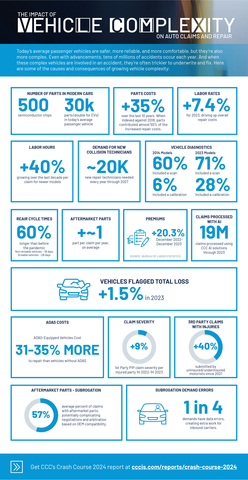CCC Crash Course Report Reveals How Labor Pressures and Increasing Vehicle Complexity Are Reshaping Auto Insurance and Collision Repair Industries
The now quarterly report identifies macro trends, business drivers, and technologies impacting consumer driving, vehicle ownership, automotive claims, and collision repair
This press release features multimedia. View the full release here: https://www.businesswire.com/news/home/20240326494539/en/

CCC Crash Course Q1 2024 Report - by the numbers (Photo: Business Wire)
The report, now on a quarterly schedule, is based on information derived from 300 million claims-related transactions and millions of bodily injury and personal injury protection (PIP) /medical payments (MedPay) casualty claims processed by CCC’s customers using the company’s solutions.
Crash Course Q1 2024 found that increasing vehicle complexity, combined with rising labor costs and shortages, are placing persistent pressure on carriers and repairers. New findings show that while vehicles may be safer, more capable of avoiding crashes, and more environmentally friendly, advanced technology is contributing to costlier repairs, higher claims costs, and longer cycle times. Additional factors, such as scheduling backlogs, have contributed to the 60% increase in the amount of time it takes for vehicles to enter repair shops after estimate completion, compared to pre-pandemic times.
“Much of what the industry is experiencing is reflective of a new normal where complexity, beginning with the vehicle itself, is reshaping the market landscape,” said
Key findings of Crash Course: Q1 2024 include:
- Auto Tech Transformation: The report identifies key challenges faced by the auto claims and collision repair industries in keeping pace with the industry’s tech transformation, such as increased costs associated with repairing advanced driver assistance systems (ADAS) and other technology.
- Electric Vehicle (EV) Repairs: EVs are becoming more common in repair assessments. Despite their youth, EV repairs carry higher costs, especially in labor. Longer repair times are common due to capacity constraints and detailed repair procedures. EVs are totaled less often than non-EVs, reflecting changing valuation trends.
- Replace vs. Repair: An emerging “replace vs. repair” trend, a preference for replacing parts instead of repairing them, demands different skill sets for the repair industry leading to higher costs for consumers. Over the past decade, the cost differential for repairing older versus newer model year vehicles has grown by 35%.
- Urbanization and Weather: Acknowledging the impact of growing urbanization and volatile weather patterns as a constant catalyst for losses, the report confirms increases in property losses from severe weather events.
- Subrogation: High turnover among adjusters is hindering subrogation efforts, leading to decreased referrals, and complicating revenue and cost reduction strategies.
- Casualty: Despite decreasing treatment duration and procedure counts for injury claims since the peak in 2021, severity continues to climb due to significant cost increases for medical bills, particularly for high-dollar procedures like radiology and surgery.
- Claims and Repair Technology: Adoption of AI and automation tools to speed and inform functions from estimating to scanning to parts ordering continue to grow as the industry looks to offset the effects of labor shortages and the complexity that comes with today’s more sophisticated vehicles.
In addition to macro trends and topics, Crash Course Q1 2024 also includes industry-level detail on claims frequency and impact severity, medical costs, parts costs, total loss trends and more.
Previously published annually, Crash Course will be published quarterly in 2024 to provide more frequent updates on key trends and insight. The Q1 2024 report is the 29th edition of Crash Course.
Download the full report at cccis.com/reports/crash-course-2024.
About CCC
Special Note Regarding Forward-Looking Statements
This press release contains forward-looking statements that are based on beliefs and assumptions and on information currently available. In some cases, you can identify forward-looking statements by the following words: “may,” “will,” “could,” “would,” “should,” “expect,” “intend,” “plan,” “anticipate,” “believe,” “estimate,” “predict,” “project,” “potential,” “continue,” “ongoing” or the negative of these terms or other comparable terminology, although not all forward-looking statements contain these words. These statements involve risks, uncertainties and other factors that may cause actual results, levels of activity, performance or achievements to be materially different from the information expressed or implied by these forward-looking statements. Forward-looking statements in this press release include, but are not limited to, statements regarding future use and performance of CCC’s digital solutions. We cannot assure you that the forward-looking statements in this press release will prove to be accurate. These forward-looking statements are subject to a number of risks and uncertainties, including, among others, competition, including technological advances and new products marketed by competitors; changes to applicable laws and regulations; and other risks and uncertainties, including those included under the header “Risk Factors” in CCC’s filings with the
View source version on businesswire.com: https://www.businesswire.com/news/home/20240326494539/en/
CCC Media Contact:
mhellyar@cccis.com | 773.791.3675
Source:
